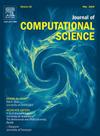DP-PINN+: A Dual-Phase PINN learning with automated phase division
IF 3.7
3区 计算机科学
Q2 COMPUTER SCIENCE, INTERDISCIPLINARY APPLICATIONS
引用次数: 0
Abstract
Physics-Informed Neural Networks (PINNs) are a promising application of deep neural networks for the numerical solution of nonlinear partial differential equations (PDEs). However, it has been observed that standard PINNs may not be able to accurately fit all types of PDEs, leading to poor predictions for specific regions in the domain. A common solution is to partition the domain by time and train each time interval separately. However, this approach leads to the prediction errors being accumulated over time, which is especially the case when solving “stiff” PDEs. To address these issues, we propose a new PINN training scheme, called DP-PINN+ (Dual-Phase PINN+). DP-PINN+ divides the training into two phases based on a carefully chosen time point . The phase-1 training aims to generate the accurate solution at , which will serve as the additional intermediate condition for the phase-2 training. The method for determining the optimized value of is proposed in this paper. Further,new sampling strategies are proposed to enhance the training process. These design considerations improve the prediction accuracy significantly. We have conducted the experiments to evaluate DP-PINN+ with both “stiff” and non-stiff PDEs, including 1D Burger’s Equation, 1D Allen–Cahn Equation, 2D and 3D Navier–Stokes Equations (i.e., 2D cylinder wake and 3D unsteady Beltrami flow). We compared DP-PINN+ with the state-of-the-art PINNs in literature, including Time Adaptive PINN, SA-PINN, bc-PINN and NSFNets.The results show that the solutions predicted by DP-PINN+ exhibit significantly higher accuracy. This paper is extended from our conference paper published in ICCS2024 Yan and He (2024) [1].
DP-PINN+:具有自动相位划分的双相PINN学习
物理信息神经网络(pinn)是深度神经网络在非线性偏微分方程(PDEs)数值解中的一个很有前途的应用。然而,据观察,标准pin可能无法准确地拟合所有类型的pde,导致对域中特定区域的预测较差。一种常见的解决方案是按时间划分域,并分别训练每个时间间隔。然而,这种方法会导致预测误差随着时间的推移而累积,在求解“刚性”偏微分方程时尤其如此。为了解决这些问题,我们提出了一种新的PINN训练方案,称为DP-PINN+(双相PINN+)。DP-PINN+根据精心选择的时间点ts将训练分为两个阶段,第一阶段训练的目的是在ts处生成准确的解,这将作为第二阶段训练的额外中间条件。本文提出了确定ts最优值的方法。此外,提出了新的采样策略,以提高训练过程。这些设计因素显著提高了预测精度。我们用“刚性”和非刚性偏微分方程对DP-PINN+进行了评价实验,包括1D Burger’s方程、1D Allen-Cahn方程、2D和3D Navier-Stokes方程(即2D圆柱尾流和3D非定常Beltrami流)。我们将DP-PINN+与文献中最先进的PINN进行了比较,包括时间自适应PINN、SA-PINN、bc-PINN和NSFNets。结果表明,DP-PINN+预测的解具有更高的精度。本文引自我们在ICCS2024 Yan and He(2024)[1]上发表的会议论文。
本文章由计算机程序翻译,如有差异,请以英文原文为准。
求助全文
约1分钟内获得全文
求助全文
来源期刊

Journal of Computational Science
COMPUTER SCIENCE, INTERDISCIPLINARY APPLICATIONS-COMPUTER SCIENCE, THEORY & METHODS
CiteScore
5.50
自引率
3.00%
发文量
227
审稿时长
41 days
期刊介绍:
Computational Science is a rapidly growing multi- and interdisciplinary field that uses advanced computing and data analysis to understand and solve complex problems. It has reached a level of predictive capability that now firmly complements the traditional pillars of experimentation and theory.
The recent advances in experimental techniques such as detectors, on-line sensor networks and high-resolution imaging techniques, have opened up new windows into physical and biological processes at many levels of detail. The resulting data explosion allows for detailed data driven modeling and simulation.
This new discipline in science combines computational thinking, modern computational methods, devices and collateral technologies to address problems far beyond the scope of traditional numerical methods.
Computational science typically unifies three distinct elements:
• Modeling, Algorithms and Simulations (e.g. numerical and non-numerical, discrete and continuous);
• Software developed to solve science (e.g., biological, physical, and social), engineering, medicine, and humanities problems;
• Computer and information science that develops and optimizes the advanced system hardware, software, networking, and data management components (e.g. problem solving environments).
 求助内容:
求助内容: 应助结果提醒方式:
应助结果提醒方式:


